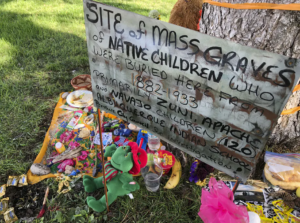Big Data, drones, diagnostics—the United Nations and other groups hope to innovate the world out of a maternal and reproductive health crisis.
TOWARD THE END of 2020, on a work trip to Chocó, Colombia, Jaime Aguirre came across a girl—perhaps 11 or 12 years old—holding a newborn.
“Is this your baby?” Aguirre asked. Yes, she said. He was shocked. “Can I ask you—sorry—why did you get pregnant so young?”
“My boyfriend at the time told me that the first time that you have sex, you don’t get pregnant,” he says she replied.
Aguirre is the innovation coordinator for the United Nations Population Fund (UNFPA) in Colombia, a human rights agency focused on reproductive health. It’s the UN’s “sex agency,” and Aguirre describes his job as bolstering health in his country by supporting new technologies. Making them accessible to young people is especially important, because pregnancy is the number one killer of girls aged 15 to 19 worldwide, according to data from Save The Children and UNFPA.
Chocó is a poor area with a large Afro-Colombian population and relatively high rates of adolescent pregnancy. People there rely more on traditional midwifery than the hospital system, so at the time he met the young mother, Aguirre was there to support Partera Vital, or Vital Midwife. The project is rolling out a mobile app to help midwives register newborns and identify risk factors and complications that warrant urgent referrals to the nearest hospital. It’s meant to combine the best of both worlds—preserving the wisdom and tradition of midwifery with the data and resources of institutional health. “Innovation culture is very important for us,” says Aguirre.
“We feel we’re one of the UN’s best kept secrets,” says Eddie Wright, a representative for UNFPA. “We want every pregnancy to be wanted, every birth to be safe, and every young person to reach their potential.” This means helping to provide people in 150 countries, including regions that are at war, with family planning, birth control, and maternal health checkups. Around the world, the agency has innovated with Big Data, drones, and even a robot in an effort to safeguard health and rights. Here’s a look at some of the projects they are leading.
Colombia
When Aguirre returned from Chocó, he was still thinking of the town’s high rates of adolescent pregnancy and maternal mortality. Myths about reproductive health must be playing a role, he thought, and reversing them should help. So he set out to identify the ones in circulation on social media.
“So I got my R,” Aguirre says, referring to the programming language, and wrote a code for scraping tweets in Spanish from anywhere in the world. “I found two myths very quickly,” he recalls. “And I was very concerned.” One discouraged people from getting IUDs by claiming that newborns could come out holding the devices in their hand; another recommended boiling condoms and drinking the water to avoid pregnancy. His team, which named the project Taboo, scaled up, capturing 12,000 tweets from Latin America and Spain that portrayed myths about contraception. They classified them into 22 prevalent themes that ranged from telling people that they can’t get STIs through oral sex to encouraging them to use Coca-Cola as a contraceptive.
The team’s data, methodology, and summaries are now available on a website meant for young women, educators, and policymakers, along with infographics debunking each myth. They’ve shared their findings with both Colombia’s Ministry of Health and district officials in Bogotá who design sex ed programs. “Behavioral change is not a thing you can measure in a short term,” says Aguirre, but he’s optimistic about the potential of his project.
The Philippines
A UNFPA team from the Philippines instituted a similar project during Covid lockdowns. The nation has one of the highest adolescent pregnancy rates in Asia—in 2017, 9 percent of 15-to-19-year-olds had children. (The Philippines’ Commission on Population and Development, known as PopCom, called it a national emergency.) Nearly a quarter of married women and half of unmarried women in the country have unmet needs for family planning.
You have questions, we have answers. Sign up for our Coronavirus Update newsletter and more, only on wired.com
“We noticed that there is limited and outdated data on family planning,” says Leila Joudane, the UNFPA’s representative in the Philippines. As in Colombia, a team began scraping online comments for more current info to supplement government demographic surveys. They used Twitter and RH-Care.info, an educational website for the Filipino public about reproductive health, and found that people were complaining about poor access to contraceptives. “It was a very strict lockdown,” Joudane recalls. “Many people online had a lot of challenges.” They shared this data with PopCom, which responded by distributing contraceptives door-to-door.
Scraping Twitter data isn’t a panacea, though. “Content analysis of social media posts is a great approach for understanding the range of different beliefs, attitudes and practices related to contraception,” says Maria Gallo, a sexual and reproductive health epidemiologist at The Ohio State University. But Gallo cautions that social media posts don’t speak for all: “They only apply to a select subset of people.”
Drew Bautista, a data analyst with UNFPA Philippines, agrees with this caveat. “It’s more of a complement,” says Bautista. “We cannot expect it to replace going to the community. That’s still the best way to actually learn, especially for those who are commonly left behind.”
West Africa
In West Africa, UNFPA is leading a more offline response to the maternal health crisis there with a project called 2 Hours to Life. Globally, more than 800 women die from pregnancy and birth complications every day, and sub-Saharan African nations bear the brunt of these, says Seydou Belemvire, who leads the UNFPA’s maternal, gender, and sexual education team in Benin.
“Timely access to quality emergency obstetric care is a challenge,” he says. The rural pockets of these nations have limited resources and many logistical barriers. “Benin is not a big country. But you have a lot, a lot, a lot of traffic jams,” Belemvire says, and these make it tricky to provide emergency materials, like blood for transfusions. Reaching a facility just 15 kilometers away from a blood distribution center in the capital can sometimes take four hours.
The new program, which launched this year with support from a Japanese pharmaceutical company, will use drones in Benin, Togo, and Côte D’Ivoire to deliver blood in under two hours. Drones have already helped transform blood delivery in rural, mountainous Rwanda. Pilot testing in Benin began early last year. “At the last kilometer, the drone will definitely be the strategy,” he says.
Over the past five years, Belemvire’s team also linked up a network of 16 maternal health centers in Benin (33 in the region). Since each facility may offer different services, they mapped out how to best provide people with fast access to care, from routine antibiotics to emergency C-sections.
The 2 Hours to Life referral program faces some challenges, though. Health facilities sometimes don’t have enough staff or necessary equipment. And some social norms contribute to delays, he says: When a pregnant woman wants to seek care, “the woman herself doesn’t have power to decide. The decision is made by another person—by the mother-in-law.” Success for the program will require buy-in from local communities, he continues. “You have to try to convince them that what we’re doing is for them and not for us, not for the government—it’s for their health.”
Global Health Prizes
UNFPA teams in Laos and the Maldives have used TikTok to train midwives and promote conversations about bodily autonomy. In Bangladesh, they’ve piloted a blockchain app for delivering menstrual supplies. In Vietnam, they set up a virtual art exhibit called “Girls Deserve to Shine,” showcasing the contributions of women to families and society. Hajar Mousannif, an AI researcher in Morocco, built SHAMA—“the first 100% Moroccan robot-woman”—who was used in a campaign against gender-based violence.
And in August, UNFPA concluded its first Joint Innovation Challenge, a competition primarily for businesses and NGOs, which collected 300 submissions from 61 countries. Ten groups won $60,000 each and a nine-month partnership with the agency to develop their project.
Among them, a Colombian project called Tirando X Colombia won with an AI chatbot designed to teach sex ed to adolescent girls. Safe YOU, built by a team from Armenia, is meant to prevent gender-based violence; if a person presses the app’s help button, it records audio and will automatically send it to preferred contacts—friends, family, police, and a network of NGOs.
The United States
The UNFPA’s programs cover 80 percent of the world’s population, especially resource-limited regions—but not the United States, where maternal mortality is also a huge problem. In fact, the rate of maternal deaths in the US far exceeds nations with comparable GDPs—23.8 deaths per 100,000 live births in 2020. That’s a big jump from 20.1 in 2019 and 17.4 in 2018. Black and Native American women are twice as likely to die as compared to white women, according to a March of Dimes report from this year. “It’s something very troubling,” says Antonello Pileggi, a program officer for the Eunice Kennedy Shriver National Institute of Child Health and Human Development. “And there is a lot that can be done.”
That’s why in September, the NIH announced its own $8 million challenge, which will award portions of that purse to individual innovators or teams from companies that can present working prototypes of new technologies. The challenge, called RadX Tech for Maternal Health, finished collecting submissions in November. Judges will be looking for technologies that have the highest potential of hitting the market in three to five years, and announce the winners in March 2024.
The NIH is focusing on funding diagnostic technologies that address the postpartum period, because in the US, the majority of maternal mortality occurs between the delivery date and a year later. A lot can go wrong: hemorrhages, infections, heart disease, gestational diabetes. An at-home test that tracks anemia after giving birth—a potential sign of hemorrhage—or detects infections could be a warning to see a doctor.
The call for proposals is intentionally nonprescriptive as the agency wants to encourage creativity, but accessibility is key. “A large portion of the nation falls under this definition of ‘maternal health care deserts,’” Pileggi says; 36 percent of US counties lack hospitals or birth centers offering obstetric care, according to the nonprofit March of Dimes.
Of course, says Pileggi, “technology is definitely not the only solution” to entrenched disparities. Governments have the power and responsibility to intervene too. But an app—or a drone, or an AI chatbot—might help it all click.




